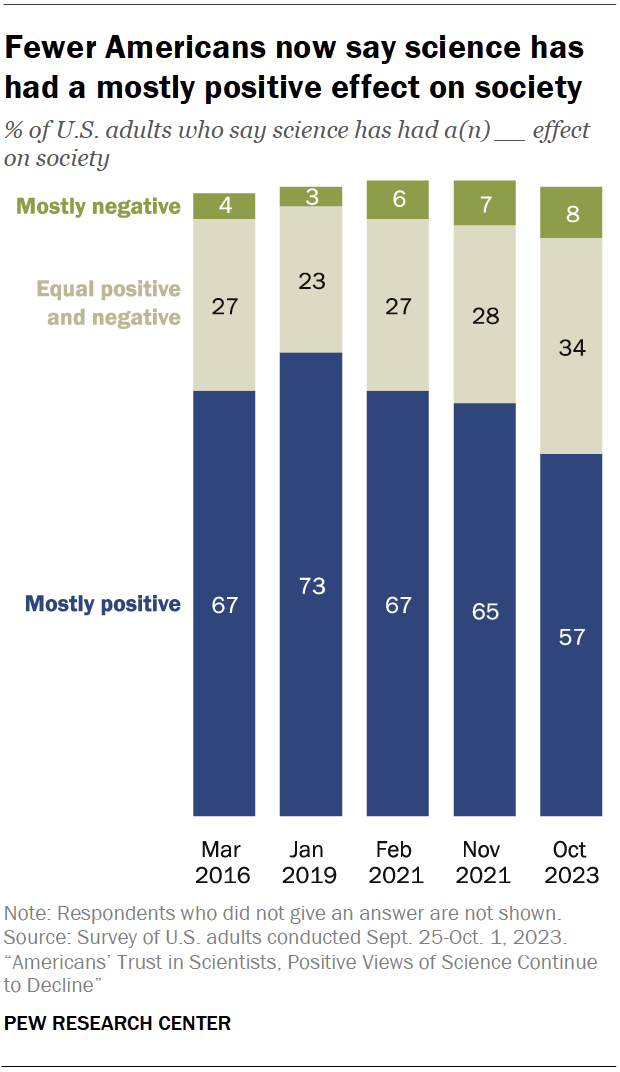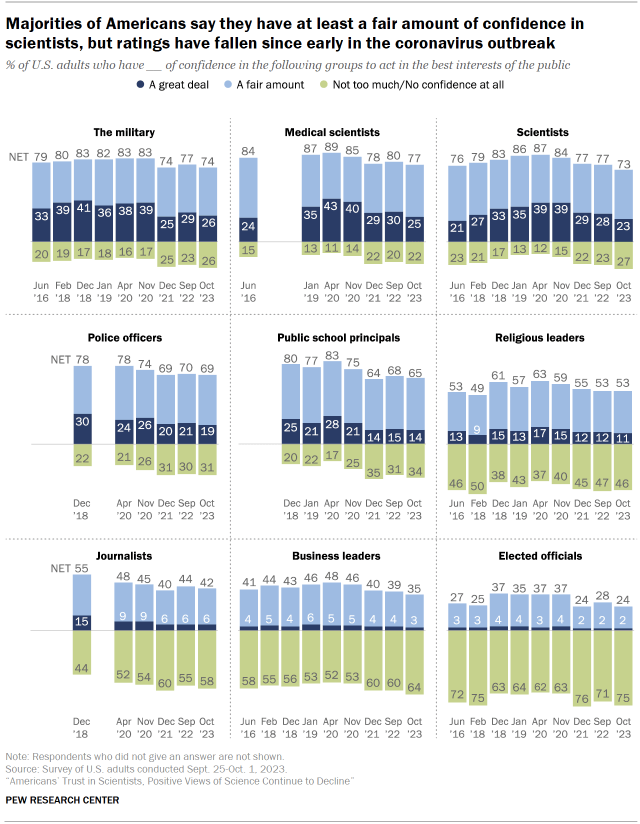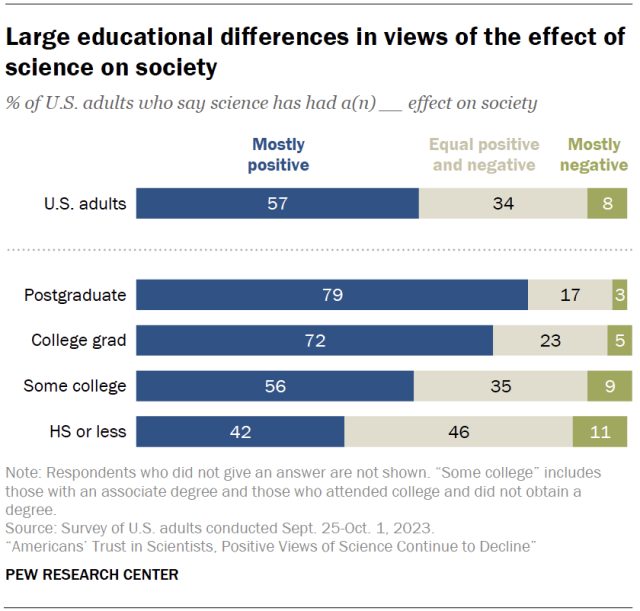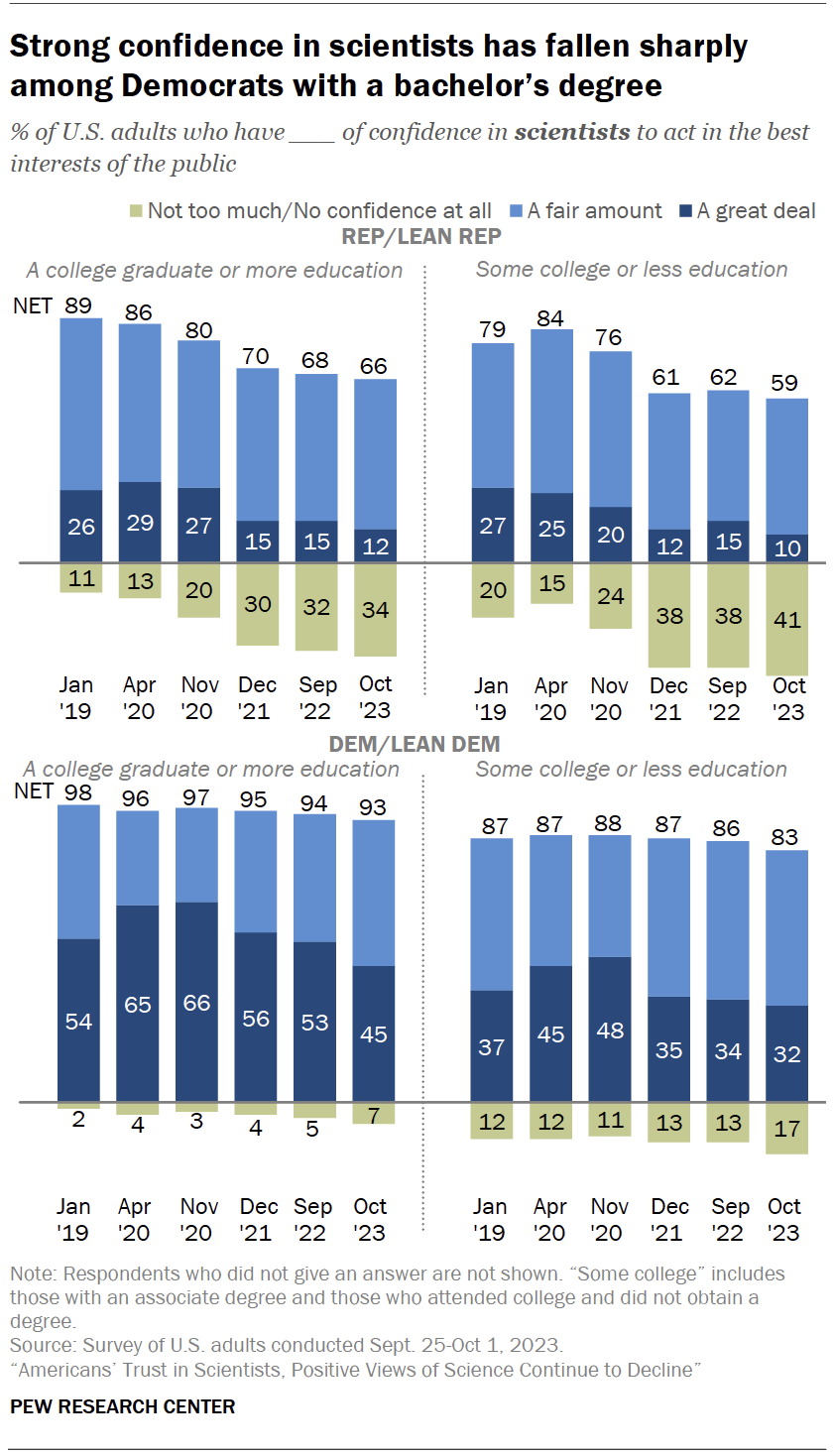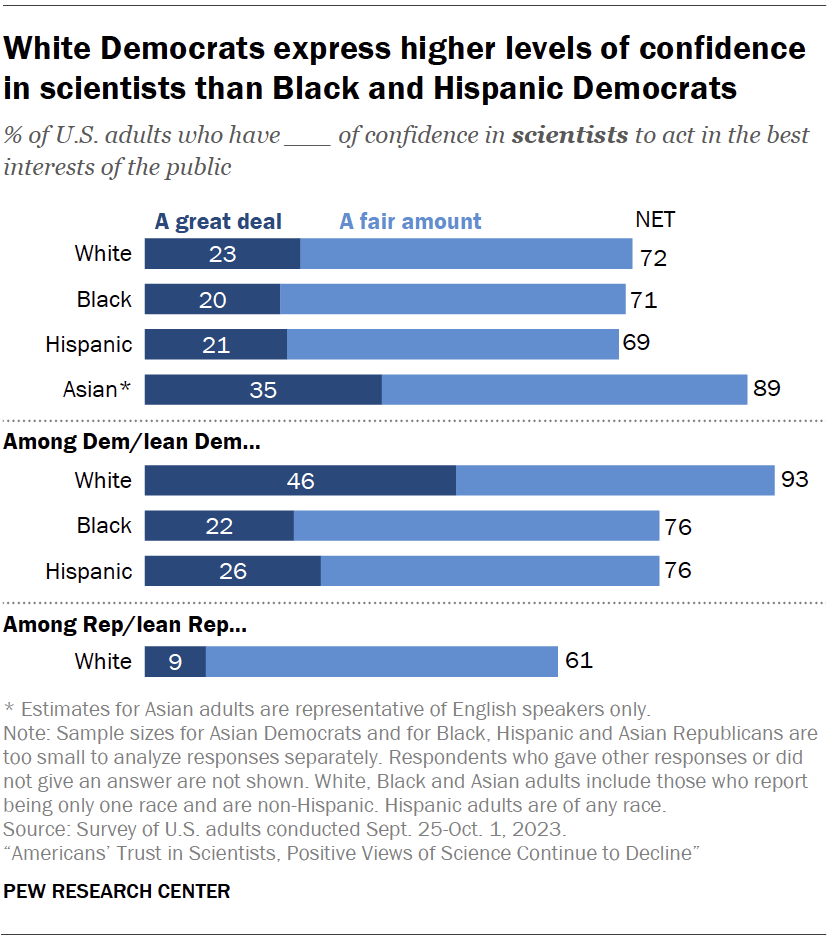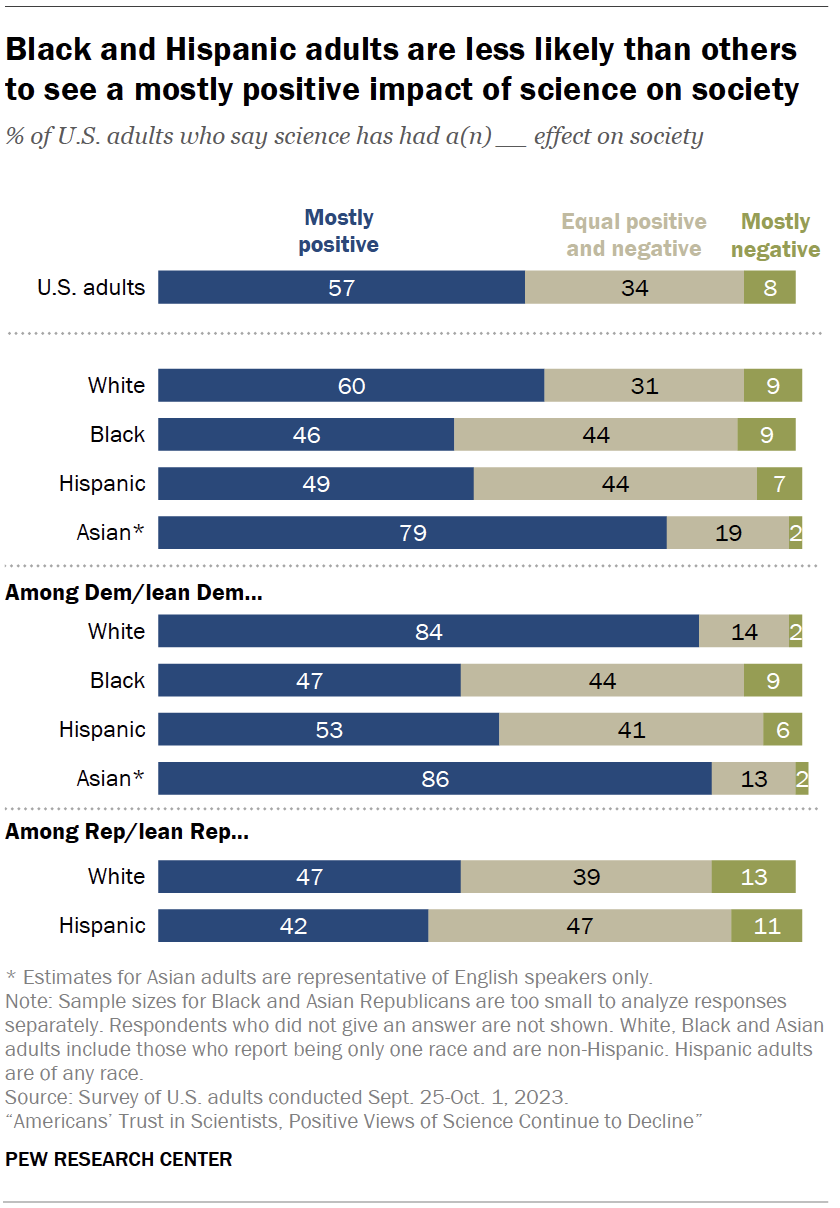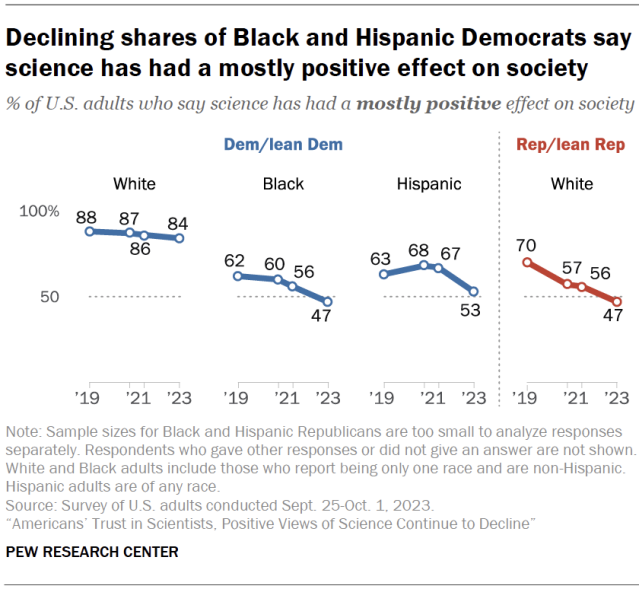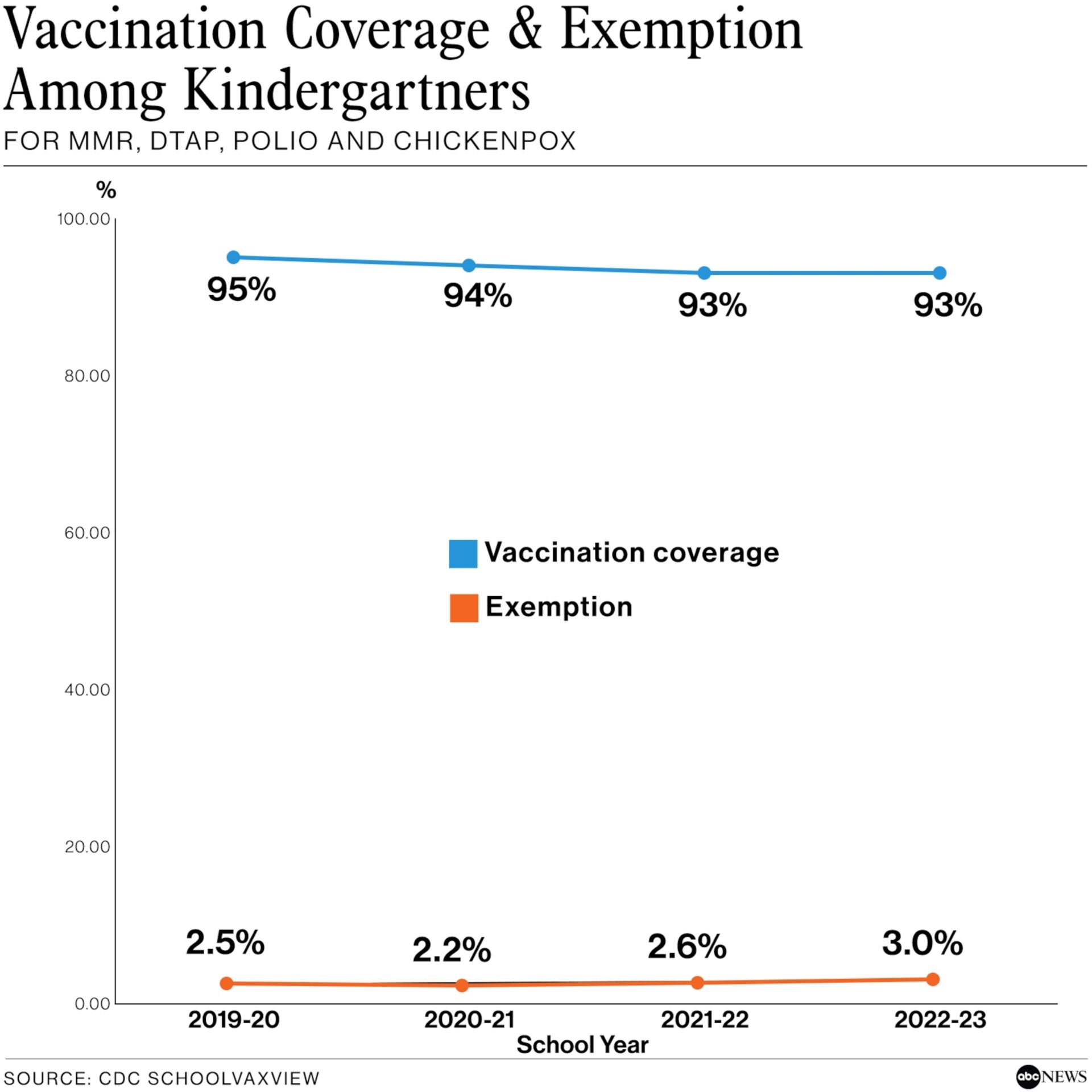As we are approaching the end of the fourth year of the COVID-19 pandemic, which has killed close to 7 million people worldwide and 1.2 million in just the US alone, both estimates being almost certainly significant undercounts of the true toll, I was depressed to see yet more evidence indicating significantly declining trust in science and science-based interventions to combat disease, such as vaccines. For example, earlier this month the Pew Research Center published survey results noting that Americans’ Trust in Scientists, Positive Views of Science Continue to Decline, with the blurb, “Among both Democrats and Republicans, trust in scientists is lower than before the pandemic.” Not long before that, there was a spate of articles about how exemptions to school vaccine requirements are now at an all-time high and COVID-19 and influenza vaccine uptake among children is very low, based on a recent MMWR study Coverage with Selected Vaccines and Exemption from School Vaccine Requirements Among Children in Kindergarten — United States, 2022–23 School Year. The news is indeed depressing for science and vaccine advocates, as has been recent news about how vaccination rates among healthcare workers for influenza and COVID-19 have been declining, based on two studies also published in MMWR, Influenza and Up-to-Date COVID-19 Vaccination Coverage Among Health Care Personnel — National Healthcare Safety Network, United States, 2022–23 Influenza Season and Declines in Influenza Vaccination Coverage Among Health Care Personnel in Acute Care Hospitals During the COVID-19 Pandemic — United States, 2017–2023. As someone who, since skipping a year around 15 years ago and getting laid up for a week with the worst case of flu I had ever had, has always gotten his yearly flu vaccine and who is also up-to-date on COVID-19 boosters, including the most recent, I nonetheless admit to little surprise at these data. After all, I’ve been writing about vaccine hesitancy and antivaccine pseudoscience and conspiracy theories for nearly 20 years.
Before I discuss why this is happening, which is, of course, a bit sarcastic, as regular readers will recognize immediately, particularly given Jonathan Howard’s post over the weekend about a certain oncologist, but I do think it’s worth unpacking. First, let’s start with the Pew Research Center survey.
Trust in science has declined since the pandemic
The Pew survey examined a number of areas related to what Americans think of science and scientists:
- Impact of science on society
- Trust in scientists
- How scientists compare to other groups
- Differences in trust in scientists based on political orientation
The survey methodology involved polling a sample of 8,842 U.S. adults from Sept. 25 to Oct. 1, 2023 taken from the Center’s American Trends Panel (ATP), an online survey panel that is recruited through national, random sampling of residential addresses. The survey was weighted to be representative of the U.S. adult population by gender, race, ethnicity, partisan affiliation, education and other categories. In addition:
Data in this report is drawn from ATP Wave 135, conducted from Sept. 25 to Oct. 1, 2023, and includes an oversample of Hispanic men, non-Hispanic Black men and non-Hispanic Asian adults in order to provide more precise estimates of the opinions and experiences of these smaller demographic subgroups. These oversampled groups are weighted back to reflect their correct proportions in the population.
A total of 8,842 panelists responded out of 9,577 who were sampled, for a response rate of 92%. The cumulative response rate accounting for nonresponse to the recruitment surveys and attrition is 3%. The break-off rate among panelists who logged on to the survey and completed at least one item is 1%. The margin of sampling error for the full sample of 8,842 respondents is plus or minus 1.6 percentage points
Unfortunately, the results of that the issue examined above are painfully predictable, as you will see, but first let’s look at the first three topics. While the vast majority of Americans agree that science has had a mostly positive effect on society, the percentage of Americans who say this has declined markedly since January 2019:
Overall, 57% of Americans say science has had a mostly positive effect on society. This share is down 8 percentage points since November 2021 and down 16 points since before the start of the coronavirus outbreak.
About a third (34%) now say the impact of science on society has been equally positive as negative. A small share (8%) think science has had a mostly negative impact on society.
Are you surprised that it’s so low? To be honest, I was a bit surprised that it was only 73% in January 2019; I would have guessed higher. To me, it’s instructive to look at the graph of the distribution of answers since 2018:
You could look at this chart and say that the percentage of Americans who think that science has had a “mostly negative” affect on society is still small, only 8%. However, it has doubled since 2019, and, although on an absolute basis, that is a relatively small increase, on a relative basis it’s huge. Think about it: The percentage of people who think science has been mostly harmful has doubled in less than five years. Also of interest is how the number who think that science has had an equal positive and negative impact, after having remained pretty stable for four years, has over the last two years increased on a relative basis by over 21%, a change reflected in the number of Americans who say that science has had a mostly positive impact, again after four years of relative stability (aside from a bit of an outlier high value in 2019), plunged by 11%.
This increasing distrust is mirrored by the next result of the survey:
When it comes to the standing of scientists, 73% of U.S. adults have a great deal or fair amount of confidence in scientists to act in the public’s best interests. But trust in scientists is 14 points lower than it was at the early stages of the pandemic.
The share expressing the strongest level of trust in scientists – saying they have a great deal of confidence in them – has fallen from 39% in 2020 to 23% today.
As trust in scientists has fallen, distrust has grown: Roughly a quarter of Americans (27%) now say they have not too much or no confidence in scientists to act in the public’s best interests, up from 12% in April 2020.
Again, the percentage of Americans who have little or no confidence in scientists to act in the publics best interests has more than doubled in less than four years. Let’s take a look at how these numbers compare to doctors, medical scientists, and other authority figures:
As you can see, there have been declines in trust in most areas, but trust in some seems more stable than others, such as the military and religious leaders. Similar to the case with scientists in general, the percentage with little or no confidence that medical scientists (which include physicians) act in the best interests of society has also roughly doubled, with a concomitant decline in the other categories.
What is, perhaps, most depressing about this study is that the decline in trust in science and scientists was not uniform. Rather, there are certain groups for which the decline was much greater than other groups. First, though, as you might expect, trust in science tends to correlate with educational attainment:
Americans with higher levels of education are especially likely to say science has had a mostly positive effect on society. About eight-in-ten adults with a postgraduate degree say this, as do 72% of those with a bachelor’s degree.
A smaller majority of Americans with some college education say science has had a mostly positive effect on society (56%). And fewer than half of those with a high school diploma or less education hold this view (42%).
The graph of the data shows this phenomenon rather starkly:
The above result is not unexpected, nor is it new. It is also somewhat reassuring in that the number of very highly educated COVID-19 minimizers and antivaxxers are clearly an incredibly tiny minority of highly educated people with PhDs and professional degrees. On the other hand, because of their advanced degrees, such physicians, scientists, and other PhDs have an outsized influence when they promote pseudoscience and conspiracy theories because of the letters after their names, particularly among people who, unlike those of us who have pointed out for a long time that an advanced degree does not inoculate against irrational beliefs, assume that those with an advanced degree, particularly in medicine or medical science, must know what they’re talking about.
The result that is particularly worrisome to me should come as no surprise to our readers, namely that trust (or, more specifically, lack of trust) in science has become very much politicized, with a huge partisan difference in trust in science and scientists. Although trust in science has also declined among Democrats, it’s most striking among Republicans:
Fewer than half of Republicans (47%) now say that science has had a mostly positive effect on society. In 2019, 70% of Republicans said this.
Read the full report here: https://t.co/qpldfH0zjs pic.twitter.com/MVtwZLS4XN
— Pew Research Science (@pewscience) November 15, 2023
As you can see from the chart above, belief that science has had a net positive effect on society has only declined slightly among Democrats and those who lean Democratic; it’s barely lower than it was in 2016, although it had increased to an even higher level between 2019 and 2021. In contrast, among those who are Republican or lean Republican, there has been a massive decline, consistent with what I’ve been discussing all along regarding, for example, the antivaccine movement.
Although the numbers are small, even among Democrats with a bachelor’s degree, there has been a marked decline in trust in science. It’s much worse among Republicans because Republicans started from a much higher baseline distrust of science, but the percentage of those expressing little or no confidence that scientists act in the best interests of society increased by more than three-fold among both political orientations, although the magnitude of the change was less among those with some college or less:
As you might recall, antivaccine beliefs used to be more or less evenly distributed between the left and the right (although when I first started writing about the antivaccine movement in 2004 there existed an exaggerated if not outright false stereotype that antivaxxers tended to be hippy-dippy crunchy lefties, particularly suburban moms, in liberal enclaves like Marin County or Manhattan). However, beginning around the time of the Tea Party wave in 2010 or somewhat earlier, the political center of gravity of the antivaccine movement began to shift rightward, a process that accelerated in 2015 with the resistance to California SB 277 (which eliminated nonmedical exemptions to school vaccine mandates), picked up more steam with the rise of Donald Trump and his victory in the 2016 Presidential election, and then was turbocharged by the pandemic, to the point where it is now very much further to the right than it ever was.
Of course, vaccine science is not the only science. I only mention it so prominently here because the antivaccine movement is the science denial movement with which I am most familiar. I also note that evolution denial (a.k.a. creationism or “intelligent design” creationism) has, due to its tight association with conservative and evangelical religions whose adherents believe in a more literal interpretation of the Bible, always also been associated far more with the political right than the left. I also can’t help but wonder whether the main drivers of the decreasing trust in science and scientists documented by this survey are vaccines and COVID-19 mitigations.
Also disturbing are the racial disparities in trust in science documented in this survey:
These results are unsurprising, given the long history of racial disparities in medicine and the legacy of abuses like the Tuskegee syphilis experiment, all of which those promoting distrust in physicians and scientists—the whole medical and scientific endeavor, actually—have been unceasingly reminding the public about in order to encourage racial minorities not to trust medicine and science.
The overall picture painted by the Pew survey is a depressing one for science advocates. Trust in science has declined since the pandemic hit, and that decline shows no signs of leveling off yet. It should not be too surprising, then, that there have been consequences to this decline in trust.
Vaccines
Going along with this general decline in trust in science and scientists, vaccination rates have not recovered to their prepandemic levels:
Vaccination rates among U.S. kindergartners for routine childhood shots have still not returned to pre-pandemic levels, according to new federal data published Thursday.
Researchers from the Centers for Disease Control and Prevention (CDC) looked at how many children met school requirements for the measles, mumps and rubella (MMR) vaccine; the diphtheria, tetanus and acellular pertussis (DTaP) vaccine; the poliovirus (polio) vaccine; and the varicella (chickenpox) vaccine.
For the 2022-23 school year, about 93% of children in kindergarten had met the vaccination requirements. That’s about the same number that was seen the previous school year, but lower than the 94% seen in 2020-21 and the 95% seen in 2019-20, prior to the COVID-19 pandemic. The latter percentage had been the standard for about 10 years.
At the same time, rates of exemption to vaccines required for school have increased:
Now, I know what some readers might be thinking. A decline of 2% in the vaccination rates of kindergarteners sure doesn’t sound like much. “Only” 2% sounds like a small decline, and it is on an absolute basis although on a relative basis going from 95% to 93% coverage represents a 40% increase in the number of unvaccinated children. Remember, also, that for the most transmissible vaccine-preventable diseases, the percentage of immune people necessary to achieve herd immunity is 95% or higher, meaning that vaccination rates need to be 95%—or preferably higher.
As the CDC report on vaccine exemptions notes in its conclusion:
The overall percentage of children with an exemption increased from 2.6% during the 2021–22 school year to 3.0% during the 2022–23 school year, the highest exemption rate ever reported in the United States (2). The percentage of children with an exemption increased in 40 states and DC. To achieve the Healthy People 2030 target of 95% MMR coverage, exemptions cannot exceed 5%. State-level exemption rates in excess of 5% prevent 10 states from potentially achieving ≥95% MMR coverage even if all nonexempt kindergartners in 2022–23 were vaccinated, up from four states in 2021–22. National MMR coverage of 93.1% during the 2022–23 school year translates to approximately 250,000 kindergartners who are at risk for measles infection.
As we’ve discussed here many times before going back to the very earliest years of this blog, what happens when overall vaccination coverage declines is that it tends to do so unevenly, with pockets of children with vaccine uptake much lower than that needed for herd immunity. You can see that from how exemption rates are now over 5% in 10 states. When that happens, we start to see outbreaks of vaccine-preventable diseases, usually starting with the most contagious of vaccine-preventable childhood diseases, measles, as happened earlier this year in Ohio where there was an outbreak that sickened 85 children, the vast majority of whom were unvaccinated.
Some states have really high exemption rates, too. For instance, Idaho has an exemption rate of over 12%, with uptake ranging from 80.7% and 81.8% for four key childhood vaccines (MMR, DTaP, polio, and varicella). That’s really low, far below what is needed for herd immunity, especially for measles. Other states with high exemption rates include Arizona (7.4%), Oregon (8.1%), Utah (8.1%), and Wisconsin (7.2%), among others. States with very low exemption rates include California (0.2%), Mississippi (0.2%), West Virginia (<0.1%), and New York (0.1%), all states that do not allow nonmedical “personal belief” exemptions to school vaccine mandates and whose exemption rates are consistent with the percentage of children who would have valid medical exemptions. Basically, restricting nonmedical exemptions to school vaccine mandates works.
Unsurprisingly, as I have pointed out before this latest CDC report was published, antivaxxers have crowed and gloated over the decline in childhood vaccination rates and the increase in nonmedical vaccine exemptions that has taken place since the pandemic. Similarly, COVID-19 contrarians in the name of unthinking fealty to evidence-based medicine precepts to the point of echoing longstanding antivaccine tropes that has led them to undermine not just confidence in COVID-19 vaccines but confidence in the entire childhood vaccine schedule, tut-tut and gloat, “I told you so,” never acknowledging their role in promoting distrust of vaccines and public health science.
Meanwhile, online, antivaxxers have seamlessly repurposed antivax rhetoric and conspiracy theories about MMR and other childhood vaccines to COVID-19 vaccines and back again:
“No no no. Avoid them all,” one person says. “Once they’re injected into the bloodstream, the metals and toxins have access to the brain and every organ!” she claims falsely. “Arm yourself with information to decline because they will pressure you.”
Others share stories of children they claim have been damaged by the MMR vaccine. Some advise the parents to “just ignore” communications from the NHS. “I keep getting letters for all my kids. It’s scaremongering. I’ve threatened my surgery with harassment if they don’t stop sending me letters,” another person says.
And:
Part of the problem, said Selvarajah, is that there is a “massive overhang” from the days of Andrew Wakefield, who in the late 1990s pushed the debunked theory that the MMR vaccine causes autism – leading uptake to plummet. Those false claims still circulate in some parent circles, he added. General scepticism about vaccines has also risen post-pandemic: “Since Covid we’ve seen a lot more hesitancy. Theories about the MMR and Covid vaccines have merged.”
As I’ve long been saying, this was always going to happen. There are only a limited number of antivaccine narratives, and they are endlessly repurposed and tweaked for new vaccines as they arise. We’ve long pointed out how doctors who voice suspicion of COVID-19 vaccines seem inevitably drawn towards the very same antivaccine narratives that have been applied to childhood vaccines since time immemorial (or at least since long before I started paying serious attention two decades ago), narrative such as claims that the disease is “harmless” (applied to both measles and COVID-19 in children, even though before the measles vaccine measles used to kill around the same number of children adjusted for population increases, as COVID-19 kills now), that “natural immunity” is better, and that vaccines haven’t been adequately tested. That last one is a favorite of Dr. Vinay Prasad, whose EBM fundamentalism led him to start parroting misleading antivaccine rhetoric about childhood vaccines having never been tested in “saline controlled” randomized clinical trials and even repeating almost word-for-word antivax “do not comply” rhetoric.
It’s not just childhood vaccines, either, nor is it just lay people. As I cited above, the CDC recently reported that vaccination rates for COVID-19 and influenza are declining among US healthcare workers. The rates are truly appalling, too, as a news story summarized:
For the first study, researchers pulled data from the CDC’s National Healthcare Safety Network (NHSN) for January to June 2023.
They found that flu vaccine coverage was 81% among health care employees at hospitals and 47.1% at nursing homes.
In terms of COVID vaccine coverage for medical workers, it was at just 7.2% at hospitals and 22.8% at nursing homes.
Again, these are appallingly low numbers, and the trend is not good either:
In a second study, the CDC researchers analyzed the same data to determine the level of flu vaccination among health care personnel.
Prior to the COVID pandemic, flu vaccine coverage rose from 88.6% in 2017-2018 to 90.7% in 2019-2020.
However, the rate declined to 85.9% in the 2020-2021 season and dropped again to 81.1% in 2022-2023.
When you can’t even get healthcare personnel to do the right thing with respect to their own health and that of their patients, you know there’s a problem.
So what’s going on?
Public health and science advocates are understandably somewhat puzzled and unhappy about these results. Of course, antivaxxers and COVID-19 minimizers (like Dr. Prasad) are quick to blame scientists and the public health apparatus exclusively. Of course, no science advocate that I’m aware of denies that part of this growth in distrust is, in part, a self-inflicted wound. The CDC’s performance very early in the pandemic, particularly with respect to testing, masking recommendations, and personal protective equipment, was not very good. The difference is that science advocates will admit this and suggest ways to do better, just as we have always criticized the FDA and CDC when they suffered lapses.
In contrast, you’ll notice how those most responsible for intentionally stoking this distrust completely ignore their role in, well, stoking this distrust since 2021 (at least). As Dr. Howard so well put it, when “reputable” doctors lecture science advocates about how it’s “entirely predictable” that parents would become suspicious of routine chlldhood vaccines, his conclusion is correct but not for the reasons he claims. Surely his incessant arguments that COVID-19 isn’t dangerous to children, like this one, had nothing to do with it:
Covid-19 is less deadly to children than many other risks we accept as a matter of course, including drowning, vehicle accidents, and even cardiovascular disease.
This was exactly how antivaxxers used to minimize the severity of measles. Indeed, this is nothing more than the Brady Bunch gambit, in which antivaxxers used to point to a 1969 episode of The Brady Bunch and other old sitcoms that played measles for laughs as evidence that measles wasn’t considered dangerous then, updated for COVID-19.
There are, of course, a number of other forces promoting distrust of science and vaccines. As Katrine Wallace, an epidemiologist and anti-misinformation advocate at the University of Illinois Chicago, notes:
Wallace attributes the rise of scientific mistrust to what she described as an “infodemic” about Covid-19: an influx of conflicting information and opinions about the virus and prevention measures.
“It led to a lot of public chaos, bewilderment, message fatigue and people just kind of checking out,” Wallace told CNN. “It just causes a lot of confusion because we have different people with big platforms saying different things.”
“Infodemic” is a term that was coined 20 years ago about the tsunami of information, in which scientifically valid information is mixed together with pseudoscience and conspiracy theories in such a way that it is almost impossible for a lay person to tell which is which, which is then amplified by the algorithms of social media that feed us what causes the most “engagement”:
In the absence of high-quality information about the Covid-19 virus, “information voids” for public health topics filled social media platforms with speculation,supplements and untested cures, she added.
In Wallace’s eyes, the system amplified disinformation and cultivated growing scientific mistrust among groups.
“Everyone was at home on social media and interacting in these echo chambers filtering out any information they didn’t want to see,” Wallace said. “Different groups come to different conclusions because they’re interacting with different information.”
Of course, much of that misinformation was, in fact, disinformation in that it was not erroneous or incorrect misinformation innocently shared, but rather the product of groups seeking to promote their own ideologically based narrative:
And often, experts say, that flood of false information was intentional and malicious — attacking scientific voices in favor of inaccurate content.
Dr. Peter Hotez, the dean of the National School of Tropical Medicine at Baylor College of Medicine, said a “revisionist history” popped up as the pandemic emerged, blaming scientists for seeding mistrust and exacerbating the harms of Covid-19.
“There was a predatory, targeted, deliberate movement from the far right trying to discredit science and scientists,” Hotez said. “The narrative that’s trying to be put out there is that the scientists did something wrong.”
Dr. Hotez is, of course, not wrong here. Far from it. All you have to do is to look at who appeared regularly on Fox News during the pandemic to promote doubt about nonpharmaceutical interventions against COVID-19 (e.g., masking, business closures, etc.) and about how dangerous the virus was in order to promote a “we want them infected” narrative pushing “natural herd immunity,” coupled with the promotion of quack cures like ivermectin and misinformation casting doubt on the safety and efficacy of COVID-19 vaccines. Unlike the way those blaming it all on scientists ignore their role in stoking distrust of science, Dr. Hotez acknowledges that we probably contributed to it:
Hotez said the scientific community can make some changes that will build trust.
“We need to up our game in terms of how we do science communication,” he said. “Stop with the old-fashioned idea of communication that we talk to the American people as if they’re in the sixth grade. Talk to them like adults.”
Universities, which Hotez believes are risk-averse, should encourage their scientists to speak out, he said.
That last part resonates with me, given the proclivity of antivaxxers and quacks dating back to long before the pandemic for trying to attack me through my employer by burying my department chair in complaints for my social media activity and trying to get me fired—or at least silenced by my job. Fortunately, there is a strong culture of academic freedom in universities that resists such efforts. Unfortunately, that same culture has protected academics promoting misinformation.
Be that as it may, just answering misinformation with good information and talking to the public “like adults” will never be sufficient. I like to cite Brandolini’s law, which states that the energy required to refute misinformation is an order of magnitude greater than the energy required to create it, and then observe that Brandolini was an optimist. My observation has been that it often takes at least two or three orders of magnitude to refute misinformation compared to what it takes to create it. We will always be at a huge disadvantage as long as we take only the approach of debunking. That’s why I’m a big fan now of “prebunking,” which involves recognizing the common narratives and conspiracy theories behind antiscience misinformation and preemptively teaching about them and trying to provide critical thinking skills that allow one to recognize new forms of old misinformation when one sees them.
In the meantime, science advocates, scientists, and physicians have their work cut out for them, as the trendiness suggest that we haven’t yet hit bottom in terms of distrust of science and medicine.


